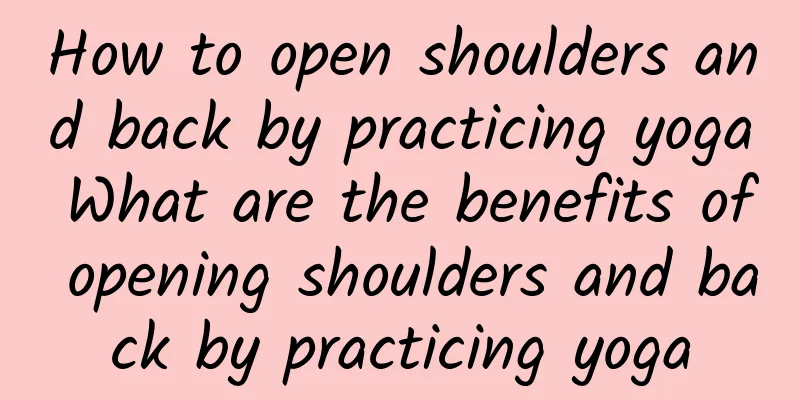How to open shoulders and back by practicing yoga What are the benefits of opening shoulders and back by practicing yoga

|
Yoga can shape the body and enhance a person's temperament. Yoga is not only practiced by women, but also by men. So how can practicing yoga open the shoulders and back? What are the benefits of practicing yoga to open the shoulders and back? How to open shoulders and back through yoga1. Lie on your back to open your shoulders and back Sit in the middle of the mat, bend your knees, spread your legs hip-width apart, and place your feet firmly on the mat. Place a yoga brick vertically just below your sternum and another behind your occipital bone. Bend your elbows and place them on both sides of your ears. Hold for 1-2 minutes. Then open your hands and place them next to your body, with your upper and lower arms at 90 degrees and your forearms against the mat. Hold for 1-2 minutes. Raise your right hand above your head and place your left hand on the left side of your body with your palm touching the ground. Hold for 1-2 minutes. Then raise your left hand above your head and place your right hand on the right side of your body with your palm touching the ground. Hold for 1-2 minutes. Then raise both arms above your head at the same time, straighten your arms with the backs of your hands touching the ground. Hold for 1-2 minutes. 2. Supine Bound Angle Pose The soles of your feet face each other, and your arms are placed naturally on both sides of your body. Different placements of yoga bricks can be used to perform different degrees of opening exercises. The first method: place the yoga brick flat on the back of the sternum; the second method: place one yoga brick horizontally on the back of the head and the other horizontally on the middle of the spine; the third method: place one yoga brick vertically on the back of the head and the other vertically on the back of the sternum. 3\ Prone shoulder and back open Kneel in the middle of the mat, spread your legs hip-width apart, exhale and move your body forward and downward, bend your elbows and place them on the yoga bricks, put your hands together behind your shoulder blades, and hold for 1-2 minutes. Then overlap two yoga bricks, straighten your right arm, place your right hand on the yoga brick, draw your abdomen inward, start from the abdomen, chest, head, and turn your entire body to the right side, support the ground with your left hand, and hold for 1-2 minutes. Switch to the other side and practice. 4. Flexible shoulders You can practice it in a standing position, kneeling position, or sitting position. Clasp your hands behind your body and stretch your arms straight. Keep the stretching position for 1 minute. While keeping your chest height unchanged, slowly raise your arms backward to your limit and hold for 1 minute. Then raise both arms above your head, hold your right wrist with your left hand, bend your body to the left and hold for 1 minute. Switch to the other side to practice. Raise your hands horizontally, stretch your right hand to the right, grab your right wrist with your left hand, turn your head and look to the right, keep the stretching position for 1 minute, twist your body slightly to the right, hold for 1 minute, and practice on the other side. 5. Flexible chest Kneel on the mat, spread your legs hip-width apart, stretch your arms forward, keep your thighs perpendicular to the ground, press your forehead and chest against the mat, then pass your left hand from under your body to the right, twist your body to the right, keep your spine extended, hold for 1-2 minutes, then switch to the other side. Practice 2-3 sets. What are the benefits of practicing yoga to open your shoulders and back?1. Reduce damage to the lumbar spine Shoulder opening exercises are a very important part of yoga asana practice. The degree of opening is closely related to the degree of posture achieved. For example, when practicing backbends (wheel pose, pigeon pose, etc.), if the practitioner does not have good shoulder and back control ability and starts practicing backbends that require the flexibility of the lumbar spine to complete, the physical damage to the practitioner is self-evident, and it is very easy to harm the lumbar spine. The most obvious is that the lumbar spine will feel tingling after practice. 2. Breathe smoothly The main reason for breathing difficulties is that the lungs have little room for movement. The size of the lung space is closely related to the degree of opening and closing of the shoulder joint. 3. Improve shoulder and neck problems According to surveys, the incidence of cervical spondylosis is about 25% for people aged 50, about 50% for people aged 60, and almost 100% for people aged 70. However, at present, the incidence is particularly obvious among young people, especially those under 40 years old. Among them, young people aged 20 to 30 have become the main force of cervical spondylosis. The younger age of shoulder and neck problems should be taken seriously by you! Through some shoulder-opening asanas, you can relax the stiff and tense muscles and activate the loose and weak muscles. Once the muscle problem is solved, the shoulder and neck problem will naturally be solved. 4. Improve your posture, keep your chest and back straight If the shoulder joint is not opened, it is usually accompanied by a hunched back posture, which is very obvious when viewed from the side and seriously affects the personal image. Tight shoulder joints will cause the pectoralis major and minor muscles to become tense, the chest curve is not obvious, and there may also be a problem of sagging chest. By practicing shoulder-opening poses, the chest muscles can be trained to a certain extent. The Importance of Yoga Shoulder OpeningShoulder opening is a process from stiffness to softness. If you don't pay attention to the inner rules, shoulder opening can also be a process of injury. The common problem is: the lumbar spine is not contracted. Using the lumbar part of the spine to open the shoulders is harmful to health. Long-term practice will cause the spine to be squeezed, worn and aged, and it also violates the principle of healthy and natural yoga practice. Shoulder opening exercises are a very important part of yoga asanas. The degree of opening is closely related to the correct practice of certain asanas. Especially in backbend exercises, some practitioners do not have good shoulder and back control ability and start some difficult backbends, such as wheel pose and pigeon pose, which use the flexibility of the lumbar spine to complete. The damage to the body of the practitioner is self-evident. Especially the damage to the lumbar spine, the most obvious manifestation is the lumbar spine tingling after practice. How to open shoulders in yoga for beginners1. Standing forward bend (hands clasped behind the back) Standing forward bend (clasp your hands behind your back) Stand up, clasp your hands behind your back, take a deep breath, open your chest, Exhale, knees soft, fold down, head gently toward the ground, neck relaxed, If you feel comfortable, bend your knees alternately and feel your shoulders open further. Hold for 5 deep breaths; 2. Dolphin pose Start from Downward Dog Pose, then kneel on the ground, bend your elbows, hold your elbows together and measure the distance. The distance between the two elbows should be the same as the width of your shoulders. Then place your forearms parallel to each other on the ground, with your fingertips facing forward, and raise your hips. Keep your head on the ground and extend your chest through your arms toward your feet, strengthening your shoulders; Hold for 5 deep breaths. 3. Reverse prayer Sit or stand, bring your hands to your sides, bend your elbows, and bring them to your back. Put your palms together in the middle of your spine, lift your hands as high as possible, and keep your spine extended and comfortable. Hold for 5 deep breaths; 4. Eagle Stand up straight, bend your left knee and bring it close to your chest. Bend your right knee, wrap your left knee around your right thigh, and hook your left foot around the back of your right calf. The right arm and the left arm are intertwined, with the right hand on top. Slowly lower yourself into a sitting position, lifting your arms up to maintain balance, with your elbows and fingertips pointing up and away from your face. Hold for 5 deep breaths. Untie your hands and legs and repeat on the other side; 5. Bow pose Lie down, bend your knees, and hold your ankles. The feet and hands stand against each other, Keep your knees hip-width apart and lift your chest off the ground. Hold for 5 deep breaths; 6. Cow Face Pose Vajra sitting position, raise your right hand to the ceiling. Bend your right elbow and bring your palm to the middle of your shoulder blade. Grab your right elbow with your left hand and press it down to strengthen the opening of your right shoulder (don’t be too hasty). If this is easy for you, reach your left hand behind your back, in the middle of your back, and grab your right hand. Gently lean back toward your arms, without putting pressure on your neck with your right arm. Hold for 5 deep breaths, then switch sides. |
>>: How is Ji Rui's blackhead removal? How to use Ji Rui's blackhead removal nose mask
Recommend
What kind of bag should I wear with a cheongsam? How to match a bag with a cheongsam
Many women should like cheongsam very much. It is...
Will I get spots if I don't remove my makeup when I go to bed? How to fix it if I wear makeup all night?
Female friends must remember to remove makeup and...
Is photorejuvenation permanent? Does it hurt?
Have you ever seen or done photorejuvenation in y...
What color pants go with a dark green top? Recommended matching of dark green clothes
Dark green is actually very nice as a top, and th...
Can the repair mask be used frequently? What is the repair mask used for?
Facial masks have always been a very popular skin...
Is it necessary to apply base coat when applying nail polish? Tips and correct methods for applying nail polish
Most girls love beauty, and they also like to hav...
Does dieting mean not eating? What does dieting mean?
Many of us know that obesity is very harmful to o...
How to check the authenticity of Innisfree? How to distinguish the authenticity of Innisfree loose powder?
Innisfree loose powder is a loose powder with exc...
Is it necessary for boys to shave their legs if they have too much hair? The harm of shaving leg hair
Almost most people have leg hair, and boys have t...
Will slimming cream burn the skin? Why does slimming cream feel hot when applied?
There are many kinds of slimming products nowaday...
What is Golden Beauty Eyelid Surgery? What is the effect of Golden Beauty Eyelid Surgery?
Everyone must have seen a lot of micro plastic su...
Is liposuction effective? Is liposuction effective?
In order to have a slimmer figure, many beauty-co...
What are the benefits of doing yoga for pregnant women? When is the best time for pregnant women to do yoga?
Yoga can not only be done on a daily basis, but p...
What can I use instead of makeup remover cotton? How to use makeup remover water without makeup cotton?
Cosmetic cotton pads are very useful. Not only ca...
How to remove oil stains on sweaters? These common items can remove oil stains
The most annoying thing in winter is getting oil ...









